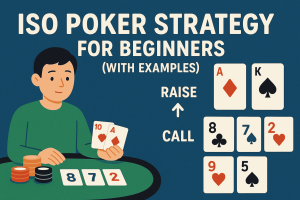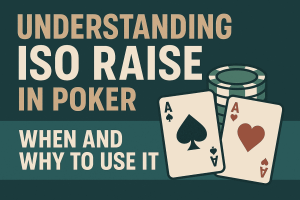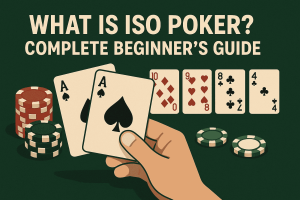One of the more technical yet essential strategies in poker is the ISO raise. If you’ve heard players talking about iso poker moves at the table or seen the term bb iso poker in tracking software, you’re on the right track to expanding your poker IQ. The isolation raise, or ISO raise, is a pre-flop strategy that allows players to take advantage of passive opponents by raising after a limp to isolate that player and go heads-up.
Whether you’re a cash game grinder or a tournament regular, understanding how and when to use the ISO raise can be a turning point in your poker journey. This guide explores the logic behind it, how it’s applied, and when to avoid it.
What Is an ISO Raise in Poker?
An ISO raise in poker occurs when a player makes a raise after another player has limped (called the big blind) before them. The intention is to “isolate” the limper and play against them one-on-one, ideally in position. The ISO raise poker concept is designed to take control of the hand pre-flop and remove other players from the pot.
For example, let’s say you are on the button and a player in middle position limps. You then raise to a size that discourages others from calling, hoping only the limper calls. This is a classic ISO raise. It’s not just about the cards in your hand; it’s about leveraging position, fold equity, and player tendencies.
Why the ISO Raise Is So Effective
The ISO raise works well because limping is often a sign of weakness or inexperience. Most solid poker strategies advise against open limping, especially in aggressive formats like No-Limit Texas Hold’em. By isolating the limper, you’re not only applying pressure to a likely weaker player but also simplifying the hand by removing other opponents from the equation.
In poker, decisions become easier with fewer players involved. Heads-up pots allow for more control and manipulation, particularly if you are in position. When you ISO raise correctly, you’re taking the initiative and can dictate the pace of the hand.
ISO Poker: The Power of Initiative and Position
One of the core benefits of iso poker play is seizing the initiative. Initiative means you’re the one applying pressure, forcing your opponent to react. If they limp-call your raise, they’re likely doing so with a weak or marginal range, often out of position.
Position matters greatly in poker. When you are in position post-flop, you act after your opponent, giving you the opportunity to gather more information before making a decision. This advantage is amplified in iso spots where your opponent’s range is capped, and they are less likely to defend aggressively.
Choosing the Right Hands to ISO Raise
A frequent question from newer players is which hands are appropriate for an ISO raise. The answer is: it depends on several factors, including your position, the limper’s tendencies, and stack sizes.
In general, strong broadway hands like Ace-Queen, King-Jack suited, or even medium pairs are ideal ISO hands. However, against very passive players, you can expand this range to include suited connectors or suited aces. The key is to isolate with hands that have strong equity or post-flop playability.
It’s important not to ISO with just any hand. Doing so without consideration can lead to tough spots, especially when other players come along or the limper surprises you with a trap.
What Is BB ISO in Poker?
The term bb iso poker refers to tracking or analyzing isolation raises in big blinds. Many online poker tools and HUDs (Heads-Up Displays) show ISO stats based on big blind sizing. For instance, if a player ISO raises to 4 big blinds after a limper, that sizing is recorded and analyzed in terms of bb iso.
This information is useful when reviewing your own game or profiling opponents. If someone ISO raises a lot and does so aggressively, they can be exploited with well-timed 3-bets. Conversely, if a player never ISO raises, you can expect them to have a tight or passive pre-flop strategy.
Understanding how to read and interpret bb iso poker stats gives you a deeper edge, especially in online environments where data is king.
Optimal ISO Raise Sizing
One of the most misunderstood aspects of iso raise poker strategy is sizing. Many players make the mistake of raising too small, which invites multiple callers and defeats the purpose of isolating. As a general rule, your ISO raise should be larger than your standard open raise, especially if there are multiple limpers.
A good starting point is raising 3x the limper’s bet, plus 1 big blind for each additional limper. So, if one player limps in a $1/$2 game, and you are in position, a raise to $8 or $10 is usually appropriate. The goal is to isolate, not to build a multi-way pot.
Proper sizing not only increases your fold equity but also discourages speculative hands from joining the pot and outdrawing you post-flop.
When to ISO Raise in Poker
Timing and player profiling are critical to knowing when to ISO raise. The best time to execute this strategy is when you’re in a later position and a loose or passive player has limped. These players tend to call wide and fold often on the flop, making them ideal targets.
Early position ISO raises can be risky, especially against unknown opponents. You don’t want to inflate a pot out of position unless your hand and read support it. Also, avoid ISO raising short stacks unless you’re prepared to call their shove or play for stacks.
Position, stack depth, and player types all factor into ISO raise decisions. It’s not a mechanical move; it’s a targeted strategy designed to exploit weakness.
When You Should Avoid ISO Raising
Despite its effectiveness, ISO raising isn’t always the right play. Against tough or unpredictable players who limp with a strong range, isolation attempts can backfire. If you’re not careful, you may find yourself ISO raising into a trap.
Additionally, if your table is full of aggressive players who 3-bet frequently, ISO raising with marginal hands can put you in tough spots. Another time to avoid ISO raises is when you’re out of position. Playing a bloated pot without positional advantage is a leak that experienced players look to exploit.
Discretion is essential. Sometimes flat calling or folding is the superior decision, depending on the dynamics at play.
ISO Raises in Cash Games vs Tournaments
The application of the iso raise differs depending on the game format. In cash games, stacks are typically deeper, and players are more consistent in their strategies. ISO raising becomes more about exploiting specific player types and establishing control at the table.
In tournaments, stacks vary, and blinds increase over time. ISO raises take on a more mathematical tone. When effective stack sizes shrink, isolation raises can become shove-or-fold scenarios, especially when targeting short stacks. Understanding risk-reward ratios, ICM pressure, and opponent tendencies is crucial when ISO raising in a tournament setting.
The core principle remains the same — isolate weaker players — but the execution must adapt to the format and stage of the game.
Advanced ISO Raise Considerations
Once you’ve mastered the basics, it’s time to consider how ISO raising fits into your overall poker strategy. Balancing your ISO range is important. If you only ISO with premium hands, sharp opponents will adjust. Including a mix of suited connectors, weak aces, and even bluffs keeps you unpredictable.
You should also monitor your own image at the table. If you’ve been raising frequently, players may be more inclined to 3-bet or defend wider, making ISO raises less effective. Conversely, if you’ve been tight, a sudden ISO raise may get more respect.
Table awareness, HUD data, and real-time reads help refine your ISO raise decisions. The more information you incorporate, the better your results.
ISO Raising and Fold Equity
A key benefit of iso poker strategy is generating fold equity. When you raise over a limp, your opponent may fold pre-flop, granting you the pot without a fight. Even if they call, your pre-flop aggression often earns you a continuation bet opportunity on the flop.
Fold equity is higher when you have a tight table image, when your opponent has shown weakness, and when you raise with an appropriate size. Learning to gauge fold equity helps you determine when ISO raising is likely to succeed.
It’s not always about having the best hand — it’s about making moves that force your opponents into difficult spots.
Conclusion: Mastering the ISO Raise Poker Strategy
The ISO raise is a powerful tactic that should be part of every serious poker player’s arsenal. It offers a way to control the hand, isolate weaker players, and play more hands profitably from position. When used correctly, iso poker moves can significantly increase your win rate and confidence at the table.
Understanding how to apply this strategy across different formats, adjusting based on opponents, and optimizing your sizing will set you apart from recreational players. Whether in cash games or tournaments, the isolation raise remains one of the most effective tools for dominating pre-flop play.
To continue learning more about professional-level poker strategy, check out this insightful article from PokerStrategy.




